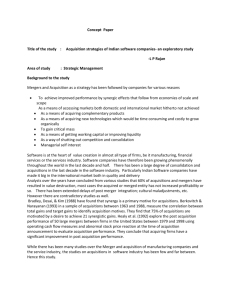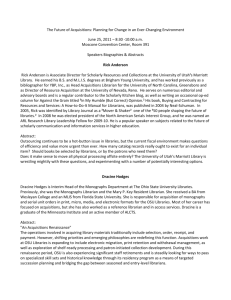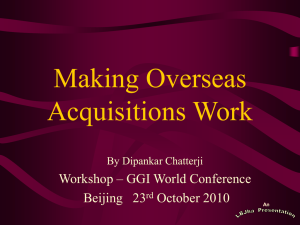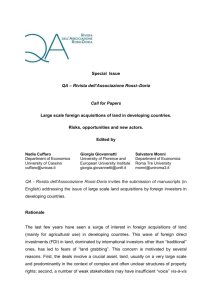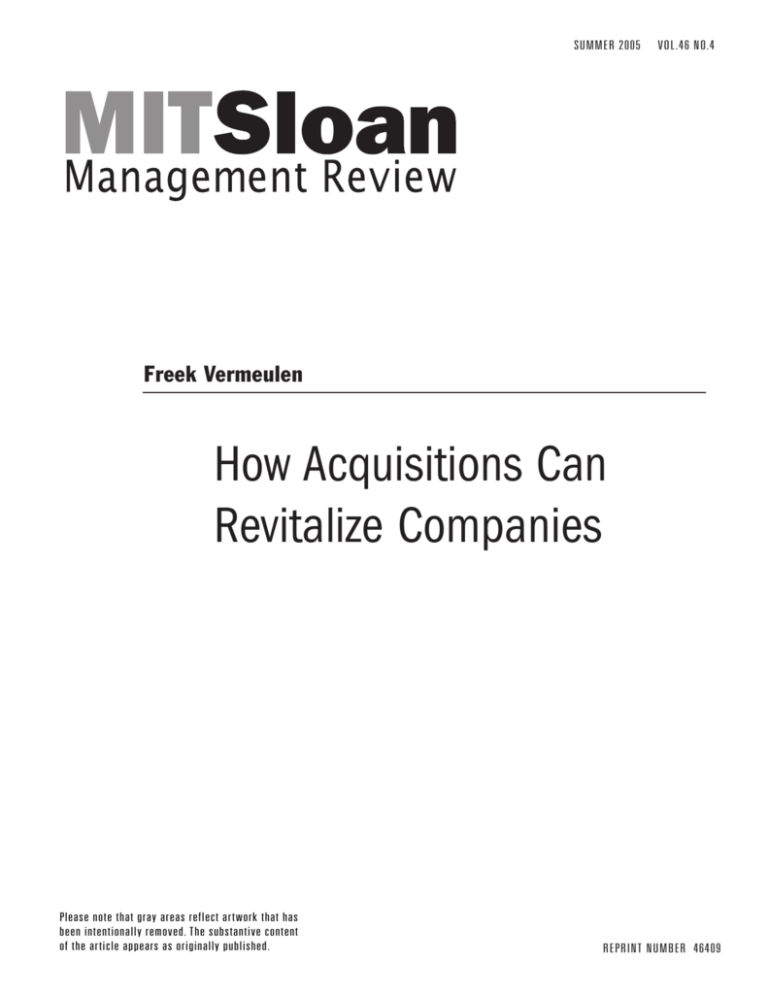
SUMMER 2005
VOL.46 NO.4
Freek Vermeulen
How Acquisitions Can
Revitalize Companies
Please note that gray areas reflect artwork that has
been intentionally removed. The substantive content
of the article appears as originally published.
REPRINT NUMBER 46409
How Acquisitions Can
Revitalize Companies
Although most companies
undertake acquisitions
with an eye toward
fueling growth, the
resulting infusion of new
ideas, perspectives and
processes can produce
lasting benefits that are
broader and deeper.
Freek Vermeulen
W
hen you ask corporate executives why they are making a particular acquisition,
they usually offer a strategic explanation, such as “The geographic spread lines up
perfectly with where we are,” or “Their product portfolio has remarkable synergy with
ours.” If you ask them two years later how the company has benefited from the acquisition, the answer is often dramatically different. They tend to focus at that point on the
“softer” factors with comments such as “They made us rethink our decision-making
processes,” or “They introduced us to a new approach to product development,” or simply “They shook up our culture.” Usually, these softer considerations had nothing to do
with the original impetus for the acquisition, yet they often turned out to be critical to
the direction of their companies.
Indeed, revitalization is an important outcome of acquisition and should be a strong
consideration when making the decision to acquire. In my research, I analyzed the acquisitions and subsequent performances of a number of large, successful companies, several
of which, at some point in their histories, had become rigid and inert in their thinking
— a well-known phenomenon that has been labeled the success trap.1 (See “About the
Research,” p. 46.) The analysis showed that the acquisitions helped the companies restore
a sense of vitality to their businesses and unleashed a subsequent surge in performance.
Indeed, the acquired companies often stimulated the acquiring companies to develop
new perspectives and different ways of doing things at times when they were most
needed. Acquisitions kept their organizations
fresh and vital. Even if the companies did not
pursue acquisitions for this reason, the
process of buying businesses and deciding
how to integrate them into their corporate
structures enabled acquirers to renew themselves before their products and operating
methods became outdated.
Consider the case of Pfizer, the pharmaceutical giant that acquired Warner-Lambert, a
conglomerate that included the pharmaceutical
division Parke-Davis, in June 2000. Management’s rationale for this acquisition was fairly
straightforward — it wanted to gain full control over the anticholesterol drug Lipitor, which
it had been jointly copromoting with ParkeFreek Vermeulen is an associate professor of
strategic and international management at the London Business School. Contact him at FVermeulen@
london.edu.
SUMMER 2005
MIT SLOAN MANAGEMENT REVIEW
45
About the Research
I conducted my research on the revitalizing effect of acquisitions in three stages over the course of five years. In the
first stage, I worked with three different companies to
examine their acquisition strategy, integration processes
and the impact the acquisitions had on organizations as a
whole. The second stage involved statistical analysis of a
sample of 25 Dutch multinationals, including Elsevier,
Wolters Kluwer, Ahold, Heineken, Vopak, DSM and Imtech
(formerly International Muller). The database consisted of
all of their acquisitions from 1966 to 1999. I estimated a
variety of statistical models — using techniques such as
logit and OLS regression analysis and survival analysis — to
assess variables including the number of acquisitions the
companies made, the businesses they were involved in,
their geographical locations and growth and profitability of
the companies. The first set of statistical models focused on
when companies undertook acquisitions in terms of periods
of growth or decline. The second set of results focused on
performance consequences of acquisitions revealing,
among other things, that companies can do too many of
them or not enough.i The third set of models examined a
company’s acquisition intensity over time. These models
indicated, among other things, that companies that regularly engage in a limited number of acquisitions performed
better than companies that alternated periods of high
acquisition intensity with periods of inactivity. In combination, these models shed light on when and how acquisitions
may revitalize companies. In the third stage of the research,
I conducted another round of in-depth interviews at seven
companies. These were specifically aimed at examining the
effects of a number of individual acquisitions about two
years after they had been completed.
i. The relationship (estimated through a fixed-effects regression analysis)
between the number of a firm’s acquisitions over the past five years and
the addition to the firm’s profitability (return on equity) in the subsequent
year was positive, indicating that these companies benefited from their
acquisitions. However, the relationship turned negative for companies
that did more than 25 acquisitions over any five-year period. This suggests that the firms in the sample that acquired heavily were negatively
affected by them in terms of their subsequent performance. The minimum number of acquisitions per five years for firms in the data set was
0, the maximum was 43.
Davis. After the acquisition, Pfizer intended to sell off WarnerLambert’s other divisions while integrating Parke-Davis into its
corporate structure. In the midst of this process, however, Pfizer
saw that many of Parke-Davis’ functions were organized differently from its own. In response, Pfizer decided not to impose its
way of doing things on the newly acquired business but rather to
allow managers to develop new processes. This created some
integration challenges. There were many reports of culture
46
MIT SLOAN MANAGEMENT REVIEW
SUMMER 2005
clashes, power struggles and people trying to maintain the status
quo. But gradually, new organizational practices began to
emerge. For example, Pfizer developed new approaches to human
resources (“Our people-management processes are better now;
we learned the softer things like talent management”); to
resource management (“Before, we were so used to having so
much money that we didn’t think about efficient use of
resources”); and to decision making (“There is now a more open
culture, a faster decision-making process”).2 The infusion of new
practices from Parke-Davis led to a revitalization of several areas
that were at risk of becoming rigid. As a result, Pfizer became a
looser and more nimble organization.
Similar changes have occurred in other organizations, changes
that later on appeared vital to the companies’ survival. Although
it is well known that successful companies often encounter success traps, we know much less about the steps they take to get out
of them or, more importantly, how to avoid falling into such
traps in the first place. My research and analysis indicates that
acquisitions can play a significant role. (See “About the
Research.”) Smaller acquisitions on a regular basis (say, every year
or two) can help managers revitalize their organizations continuously, before rigidity and complacency set in. Acquisitions can
trigger a process that I refer to as hybrid vigor,3 a term borrowed
from genetics that introduces variety to organizations and introduces managers to new things they may not even realize they
need. Once managers are aware of this effect, some elect to
undertake acquisitions specifically for this reason.
The Value of Cross-Fertilization
Companies make acquisitions for a variety of reasons: to get
access to a new business or technology, to gain a foothold in a
new geographical market or to consolidate a market. Some companies seek to learn something, such as a particular skill or capability that they identify as useful. All acquisitions, however,
require that companies find ways to integrate organizations that
do things differently. Pfizer, for instance, originally bought ParkeDavis for strategic reasons, but while integrating it and seeing
how differently it operated, management realized how rigid and
complacent Pfizer had become. As one manager put it, “We were
so successful, which had led to an insular, comfortable state of
mind. This acquisition was a consciousness-raising exercise. It
made us realize that we could do better; now we realize there are
other ways of doing things.”4 An acquisition can remind management that there are different ways of doing things and that it
may be time for them to consider change.
The realization that companies could and should operate differently often triggers another learning effect. For instance, in the
wake of acquisitions the merged company sometimes develops
completely new processes and systems that the individual companies had not considered before the acquisition nor could have
One Snapple manager put it this way: “We have learned from Nantucket Nectars’ expertise in
guerrilla marketing activities. They reacquainted us with how to execute on the street level.”
developed by themselves. This was not simply a matter of the
acquiring company adopting practices or technologies of the
other companies; it involved a cross-fertilization of core elements
of the organizations’ “DNAs,” which formed something that was
altogether new.
For example, rather than adopting the practices of ParkeDavis, Pfizer management chose to develop completely new
practices for HR, resource management and decision making.
This was similar to the approach followed by Swatch Group
Ltd., headquartered in Biel, Switzerland, which is often cited as
an example of how innovation can alter competition within an
industry. Although Swatch may be best known for rescuing the
Swiss watchmaking industry from oblivion, equally noteworthy
is how Swatch was formed by the merger between two struggling watch companies, ASUAG and SSIH. ASUAG had the
engineering and production expertise and SSIH provided marketing and branding skills, but neither company could have
come up with the innovation alone; it required a complete overhaul of market positioning, distribution and manufacturing
technology. As Swatch CEO Nicolas Hayek put it, “It created
new possibilities and a new culture.” Acquisitions can introduce
new values, beliefs, skills and knowledge, which when blended
with the company’s existing repertoire can lead to a new set of
practices.
Acquisitions can help companies retain or recover their vitality. Snapple, the U.S. beverage company, is a case in point. Snapple became successful by launching innovative products, based
on fruit juices and teas, into the beverage market. But it was hard
for the company to maintain its reputation for being funky and
flexible. Over the last few years, Snapple completed several acquisitions (including Mistic, Orangina, Yoo-hoo and Nantucket
Nectars) in an effort to extend its market reach and eliminate
some competition. The acquisitions have also helped the company counter the advances of rigidity and inertia. Each acquisition has helped to restore the sense of feistiness that Snapple had
begun to lose. Take, for example, the acquisition of Nantucket
Nectars in 2001. As one manager said, “The acquisition was first
of all financially driven. We wanted to expand our product offering; we saw the complementarities of our product lines and
wanted to shed costs.” But later, management realized that buying
Nantucket Nectars affected the company in other ways, too. One
of the most important areas of influence was marketing. One
manager put it this way: “We have learned from Nantucket Nectars’ expertise in guerrilla marketing activities — how to execute
them on the street level. They have reacquainted us with this.”
According to a former Nantucket Nectars manager, “They [Snapple managers] have learned our grassroots approach to marketing.” Snapple picked up valuable knowledge from Nantucket
Nectars, which, in turn, learned other things from Snapple. A former Nantucket Nectars manager said: “We have learned a ton
from them. They [Snapple] were much more educated in consumer insights research, in the science of marketing, in datatracking research, in the financial proposition — the numbers
stuff.” The melding of different knowledge bases has helped
Snapple regain some of its former vitality.
Making Organizational Revitalization Happen
Acquisitions can introduce companies to different organizational practices5 and lead the way to organizational revitalization. However, this does not always happen. For example,
whereas Snapple may have benefited greatly from the integration of Nantucket Nectars, the Quaker Oats Co.’s acquisition of
Snapple in 1994 clearly did not achieve the same level of success. In fact, Quaker Oats turned around and sold it off again
in 1997 in response to severe financial losses. There are several
principles that can help acquirers achieve revitalization through
acquisitions.
Select Acquisitions You Can Learn From The first thing managers
need to do is understand the characteristics of the acquisition
target. Acquisitions can only bring variety to acquiring companies if they are different in some important respects. If the two
companies have too many of the same characteristics and are
managed in much the same way, they cannot really learn from or
cross-fertilize each other. However, organizations can also be too
different.6 The greater the differences, the more difficult it is for
the acquiring company to absorb the acquisition. (See “Gauging
the Revitalization Potential of an Acquisition Target,” p. 48.)
Snapple and Nantucket Nectars, for example, had some important similarities in terms of their products and customers, but
they were different in terms of their cultures and business
processes, and therefore could enrich each other. If the gap
between the two companies had been much larger, the acquiring
company wouldn’t be able to grasp and relate to the acquisition’s
SUMMER 2005
MIT SLOAN MANAGEMENT REVIEW
47
Gauging the Revitalization Potential of an Acquisition Target
Potential to
Cross-Fertilize
STEP 1
STEP 2
The questionnaire below is designed to help managers determine the revitalization potential of acquisition candidates. It
assesses organizational differences on six dimensions: customers, country, product, distribution, processes and systems,
and organizational culture. Each dimension represents a different aspect of strategic and organizational similarity.
Compare score with
the graph at right.
In general, a company’s score should
be above 20 but
below 50. A score
below that range
indicates that the
0
10
20
30
40
50
60
70
candidate is too simDifference Score
ilar to provide much benefit. A score above it suggests that the
target is too different.
MUCH
THE SAME
PARTIAL
OVERLAP
VERY
DIFFERENT
HOW DIFFERENT IS THE CUSTOMER BASE?
Breadth of the customer base
0
1
2
3
4
Consumer versus business-tobusiness
0
1
2
3
4
Price versus differentiation focus
0
1
2
3
4
STEP 3
HOW DIFFERENT IS THE GEOGRAPHICAL PRESENCE?
Geographic location (that is,
distance)
0
1
2
3
4
Language of home countries
0
1
2
3
4
Dominant religion in countries
0
1
2
3
4
HOW DIFFERENT IS THE PRODUCT PORTFOLIO?
Product/service mixture
0
1
2
3
4
Breadth of product portfolio
0
1
2
3
4
Research and development
intensity
0
1
2
3
4
In some cases, it is useful to acquire a company that is similar
to yours; in others, it is useful to acquire a company that is different. It depends on the size of the acquisition and your company’s state of performance. Apply the conversion below to
your score to check if this applies.
Company’s financial
performance in recent years
HOW DIFFERENT ARE THE DISTRIBUTION CHANNELS?
STABLE
1
3
4
5
10%
5%
≤ 2%
3
4
5
2
≥ SAME 30%
Size of the acquisition
candidate, as compared to you
DECLINING
IN RECENT
YEARS
CONSISTENTLY
IMPROVING
1
2
Marketing intensity
0
1
2
3
4
Physical logistics
0
1
2
3
4
Integration of supply chain
0
1
2
3
4
‘your
score’
Compare the adjusted score to the graph above. Your adjusted
score should still be well above 20 but below 50.
HOW DIFFERENT ARE WORK PROCESSES AND SYSTEMS?
Structured versus unstructured
0
1
2
3
4
Flat versus hierarchical
0
1
2
3
4
Loose versus tight control
0
1
2
3
4
HOW DIFFERENT IS THE ORGANIZATION’S CULTURE?
Open versus closed
0
1
2
3
4
Process versus results oriented
0
1
2
3
4
Formal versus informal
0
1
2
3
4
TOTAL SCORE (OUT OF 72):
YOUR ADJUSTED SCORE:
(
) (⁄
1
score −3) +3
× ⁄2 (performance
×
3
1
2
3
(size score −3) +3
)
The adjustment factor indicates that it is OK if your acquisition
candidate is like your company if:
■ It is a relatively large acquisition, and
■ Your own performance has been worsening for several years.
The adjustment factor also indicates that it may work to
acquire a company that is quite different from you, on several
dimensions, as long as:
■ Your performance is improving, and
■ The company to be acquired is relatively small.
NOTE: Strategic similarity is assessed following Markides’ “who, what, how” model. See C. Markides, “All the Right Moves: A Guide to Crafting Breakthrough Strategy” (Boston: Harvard
Business School Press, 1999). This model assesses (1) who is the company’s customer (in this test divided in “customer base” and “geographic presence”), (2) what is the product (“product
portfolio”), and (3) how to get the products to the customers (“distribution channels”). The items for organizational similarity (“work processes and systems” and “organizational culture”)
are adapted from G. Hofstede, B. Neuijen, D. Ohayv and G. Sanders, “Measuring Organizational Cultures: A Qualitative and Quantitative Study Across Twenty Cases,” Administrative Science Quarterly 35, (1990): 286-316; B. Neuijen, “Diagnosing Organizational Cultures” (Groningen: Wolters-Noordhoff, 1992).
48
MIT SLOAN MANAGEMENT REVIEW
SUMMER 2005
processes and systems and blend them with its own. The research
indicates that organizations can only understand and learn from
each other if they have some things in common. Without a common base of understanding (about products, customers or cultural heritage), it is difficult to blend practices, and the
companies can’t easily fertilize each other. For example, my statistical analysis showed that for companies that acquired a foreign competitor without ever having operated abroad and for
companies that acquired businesses in industries they weren’t
active in before, the benefits were limited. These acquisitions had
very little effect on the vitality of the acquirer. 7
Link the Size of the Acquisition to Corporate Need Corporate executives often wonder how big their acquisitions should be. There is
no hard-and-fast rule, but the size of an acquisition should bear
some relation to the amount of trouble the company is in. Big
acquisitions can be very disruptive. However, if the company is
stuck in a success trap and unable to break out of existing constraints, a big disruption may be good. The two companies that
merged into the Swatch Group were both in severe trouble.
Therefore, they needed a significant merger to bring about the
necessary changes; a smaller deal wouldn’t have been enough to
shake things up. The merger of drug companies Hoechst and
Rhône Poulenc in 1999 provides another useful example. Both
companies were struggling financially. Yet their merger led to the
formation of Aventis SA, a vibrant and fast-growing multinational life science company (now part of Sanofi-Aventis). On the
other hand, when a company is experiencing healthy internal
growth, a big acquisition might be too disruptive and do more
harm than good. Smaller acquisitions may be more suitable for
maintaining vitality. Networking equipment maker Cisco Systems of San Jose, California, has a long history of buying small
companies for their innovative technology. However, people at
Cisco also acknowledge that the process of integrating companies
has helped the company maintain its own organizational energy
and entrepreneurial spirit.8
Integrate Acquisitions, But Don’t Destroy Them It is well known that
efforts to integrate acquired companies often result in frustration
and friction. Therefore, many managers try to avoid these problems either by leaving acquired companies alone or by quickly
and completely assimilating them — in effect, forcing people to
adapt fully or leave.9 Although the companies that were able to
revive their businesses through acquisitions have followed different approaches, they have one thing in common: They
approached organizational differences head on, through a
process that I call blending. Revitalization cannot occur if acquisitions are isolated from the rest of the company; nor will it occur
if the acquired company’s values and practices are suppressed
through complete assimilation.
Blending allows companies to enrich each other and create
new organizational practices. Companies often assume that simply bringing people together will be sufficient, that they will automatically learn from each other. However, the research shows that
bringing people together in and of itself won’t do much. Rather,
a well-designed integration process requires that people from
both parties identify best practices and agree on follow-up
processes to ensure that the practices are actually put in place. It
also means assigning people from the acquired unit to tasks and
responsibilities for the wider company. In many cases, this has
involved establishing teams consisting of people from both
organizations with at least two persons from each company, thus
preventing differing viewpoints from being ignored.10 In addition, it is useful for managers from the acquired unit to be
assigned responsibilities in the acquiring company in order to
stimulate the diffusion of the acquisition’s values and practices.11
The process of blending can begin either when the acquisition
still exists as a separate unit or after it is merged into the larger
company structure. Either way, a new repertoire can be created
that is unique from those of the previous companies. Pfizer, for
instance, made the explicit choice not to assimilate Parke-Davis;
instead, it developed an integration structure that was designed
to produce a new set of practices. Management referred to this
process as two in the box; for every function and geographical
area, one lead person was selected from Pfizer and one from
Parke-Davis. Together, the individuals co-chaired a task force to
“identify the processes in that area, to decide which process was
better or to create a new one.”12
Embrace Friction Most efforts to combine organizations are complicated by power struggles, culture clashes and disputes over
who is responsible for what and whose process works better.
However, integration problems should not be viewed as problems on their own but as part of a larger effort to re-examine old
methods and routines. The integration of Nantucket Nectars into
Snapple offers a case in point. Initially, the former Nantucket
Nectars employees found it difficult and cumbersome to work
with the Snapple people and vice versa. Snapple people complained that former Nantucket Nectars employees were disorganized in that they didn’t “have any hierarchy and processes,” so that
they “were putting out fires all the time.” They also complained
that “Nantucket managers lacked specialization, which diluted
their time and attention,” forgetting “to look at strategic issues, as
opposed to day-to-day sales.” Nantucket Nectars people, in turn,
considered Snapple “a conservative environment,” and complained that they “had to get approval for everything” and that
Snapple people didn’t have as much appetite for “gut and passion
and hard work” as they had. As a consequence, the initial period
after the acquisition integration was uncomfortable and disturbing for both sides. But in hindsight, many people came to realize
SUMMER 2005
MIT SLOAN MANAGEMENT REVIEW
49
At the time of the acquisition, the culture clashes seemed troublesome and obstructive, but
they also made Snapple managers realize that their company was in need of renewal.
that working through the differences brought real benefits. As
one Snapple manager said, “At the time of the acquisition, we saw
issues around culture as second or third in importance but afterwards we realized that this brings good things. The people from
Nantucket Nectars bring a sense of passion for what they do. The
influx of their management has been a breath of fresh air.” At the
time, the culture clashes seemed troublesome and obstructive,13
but they also made Snapple managers realize that the company
was becoming bureaucratic and in need of renewal. Although
acquisitions can create turmoil, they can also point management
to areas where they need to change.
Balance Acquisitions and Organic Growth A final condition that can
influence the extent to which acquisitions revitalize companies is
top management’s overall attitude toward growth. Do managers
want to grow through acquisitions, or do they prefer organic
growth? Some top managers spend much of their time scanning
for acquisition candidates and potential deals. They view the
company as a portfolio of businesses to be assembled and managed. Others prefer to avoid acquisitions, either because they have
heard of difficulties or experienced them firsthand. They see the
company as an organization to be grown from within. However,
the research shows that companies that managed to sustain
growth best didn’t adhere to one approach to the exclusion of the
other. Rather, they expanded through a mixture of acquisitions
and organic growth and balanced the two over time.14 This suggests that the two modes of growth are not substitutes for one
another but complementary.
Throughout the 1990s, Ahold, the Netherlands-based retailer
that acquired various supermarket chains largely in the United
States, succeeded at balancing the two approaches to growth.
Management explicitly wanted growth through acquisitions and
internal growth to complement each other.15 The way management saw it, the acquisitions were not so much an avenue for
growth by themselves but platforms for further expansion. In
addition to carefully selecting companies to buy, Ahold went to
great lengths to integrate them, extracting knowledge wherever
possible in hopes of creating further opportunities for growth.
Gradually, however, management’s emphasis began to shift. Management increasingly relied on acquisitions as replacements for,
rather than enablers of, autonomous growth. By 2003, Ahold was
depending on acquisitions almost exclusively to meet its growth
50
MIT SLOAN MANAGEMENT REVIEW
SUMMER 2005
targets. Management’s efforts to integrate its various businesses
were all but abandoned.16
AS TIME GOES ON , successful companies tend to become less
open in their thinking and less receptive to different ways of
operating. They become less responsive to changes in their environments. Some companies, however, have found that acquiring
new companies restores vitality, which ultimately increases their
bottom line. To be sure, integrating acquired companies causes
major disruptions in the status quo, and it often leads to painful
clashes between those representing the old guard and those promoting the new, but it is often these very conflicts that generate
the revitalizing benefits.
ACKNOWLEDGMENTS
I would like to acknowledge the helpful comments of Marcus Alexander,
Julian Birkinshaw, Costas Markides, Don Sull and the late Sumantra
Ghoshal.
REFERENCES
1. This is often referred to as the success trap or a competency trap.
See, for instance, D.N. Sull, “Why Good Companies Go Bad,” Harvard Business Review 77 (July/August 1999): 43-52; D. Miller, “What
Happens After Success: The Perils of Excellence,” Journal of Management Studies 31 (1994): 325-358; D.A. Levinthal and J.G. March,
“The Myopia of Learning,” Strategic Management Journal 14 (1993):
95-112.
2. Personal communications, February to April 2003.
3. Hybrid vigor occurs when a large, secluded population whose gene
base has grown narrow over the years is combined with a relatively
small group with a different set of genes. Although in itself a small
event, it may trigger an exponential process that in a short period of
time restores the variety in the population’s gene base, enabling it to
avoid decline and readapt to its environment. For instance, there is
some evidence that this effect took place in Polynesia when the mutineers of the H.M.S. Bounty took their Polynesian wives. An acquisition
may have a similar effect on a larger firm; the practices of the
acquired unit may combine with those of the acquiring corporation to
enable the creation of a new repertoire, in terms of the firm’s beliefs,
systems and practices, which revitalizes the entire company. See L.F.
Keller and D.M. Waller, “Inbreeding Effects in Wild Populations,”
Trends in Ecology & Evolution 17 (2002): 230-241; P.K. Ingvarsson,
“Restoration of Genetic Variation Lost — The Genetic Rescue Hypothesis,” Trends in Ecology & Evolution 16 (2001): 62-63.
4. Personal communication, April 2003.
5. There may be other ways. Prior research, for instance, shows how
a firm’s foreign subsidiaries may bring fresh approaches from their
local environment into the firm. See J. Birkinshaw, “Entrepreneurship
in Multinational Corporations: The Characteristics of Subsidiary Initiatives,” Strategic Management Journal 18 (1997): 207-229; J. Santos,
Y. Doz and P. Williamson, “Is Your Innovation Process Global?” MIT
Sloan Management Review 45 (summer 2004): 31-37. For a similar
effect for a variety of product markets, see D. Miller and M.-J. Chen,
“Sources and Consequences of Competitive Inertia: A Study of the
U.S. Airline Industry,” Administrative Science Quarterly 39 (1994):
1-23. Hiring executives from outside the company may also bring in
fresh ideas. See, for instance, D.W. Boeker, “Executive Migration and
Strategic Change: The Effect of Top Manager Movement on ProductMarket Entry,” Administrative Science Quarterly 42 (1997): 213-236.
6. See P.J. Lane and M. Lubatkin, “Relative Absorptive Capacity and
Interorganizational Learning,” Strategic Management Journal 19
(1998): 461-477.
7. Specifically, in a series of panel data and survival models, the financial performance and success rate of the acquiring companies was
regressed on their number of acquisitions during the preceding five
years. The effect was generally positive. In contrast, the effect of
acquisitions in unrelated businesses (measured through the companies’ SIC codes) and the effect of acquisitions in regions in which the
firm had not been active before were statistically insignificant.
8. P. Puranam, “Grafting Innovation: The Acquisition of Entrepreneurial
Firms by Established Firms” (Ph.D. dissertation, University of Pennsylvania, 2001); P. Puranam, H. Singh and M. Zollo, “A Bird in the Hand
or Two in the Bush? Integration Trade-Offs in Technology-Grafting
Acquisitions,” European Management Journal 21 (2003): 179-184.
9. For some pairwise comparisons between these two approaches
see, for instance, R.F. Bruner, “Applied Mergers and Acquisitions”
(New York: John Wiley & Sons, 2004): 895-900.
10. For empirical evidence on this topic see C.B. Gibson and F. Ver-
meulen, “A Healthy Divide: Subgroups as a Stimulus for Team Learning Behavior,” Administrative Science Quarterly 48 (2003): 202-239.
11. Snapple, for example, carefully retained core people within Nantucket Nectars, and after discovering their value made sure to promote
them within the larger company to stimulate cross-fertilization. See
also M.E. Graebner, “Momentum and Serendipity: How Acquired
Leaders Create Value in the Integration of Technology Firms,” Strategic Management Journal 25 (2004): 751-778.
12. Thus, blending is designed to create something new. As Igor Landau, chairman of Aventis, put it, “The strategy was to create a new
company and not be the sum of the two previous companies. We
decided either we create something new or we would pay the price
down the line.”
13. For a more specific focus on the role of culture in acquisition integration, see J.R. Carleton and C.S. Lineberry, “Achieving Post-Merger
Success” (New York: John Wiley & Sons, 2004).
14. See also F. Vermeulen and H. Barkema, “Learning Through Acquisitions,” Academy of Management Journal 44 (2001): 457-476.
15. As CEO Cees van der Hoeven put it on Oct. 29, 1999: “How do we
realize growth? In the first place, through strong autonomous growth. As
a second course of growth, we regularly add small takeovers to existing
store chains. This year, for example, we announced a number of acquisitions in Spain, Poland, Argentina and Brazil. Absolutely essential is
that both parties, for the benefit of all stakeholders and particularly the
consumer, can increase each other’s value.”
16. Early in 2003, Ahold had severe financial difficulties and CEO Van
der Hoeven was forced to step down.
Reprint 46409. For ordering information, see page 1.
Copyright © Massachusetts Institute of Technology, 2005. All rights reserved.
SUMMER 2005
MIT SLOAN MANAGEMENT REVIEW
51
PDFs ■ Reprints ■ Permission to Copy ■ Back Issues
Electronic copies of MIT Sloan Management Review
articles as well as traditional reprints and back issues can
be purchased on our Web site: www.sloanreview.mit.edu
or you may order through our Business Service Center
(9 a.m.-5 p.m. ET) at the phone numbers listed below.
To reproduce or transmit one or more MIT Sloan
Management Review articles by electronic or mechanical
means (including photocopying or archiving in any
information storage or retrieval system) requires written
permission. To request permission, use our Web site
(www.sloanreview.mit.edu), call or e-mail:
Toll-free in U.S. and Canada: 877-727-7170
International: 617-253-7170
e-mail: smrpermissions@mit.edu
To request a free copy of our article catalog,
please contact:
MIT Sloan Management Review
77 Massachusetts Ave., E60-100
Cambridge, MA 02139-4307
Toll-free in U.S. and Canada: 877-727-7170
International: 617-253-7170
Fax: 617-258-9739
e-mail: smr-orders@mit.edu
Reproduced with permission of the copyright owner. Further reproduction prohibited without permission.




